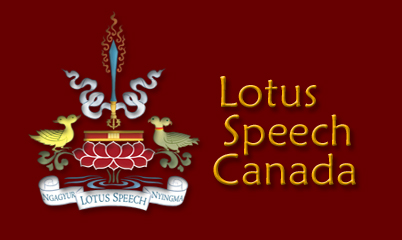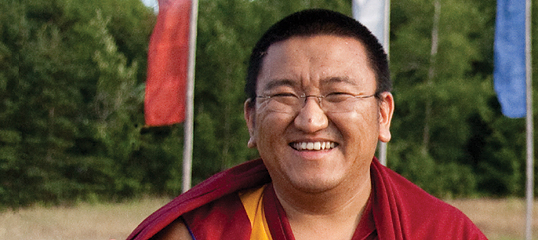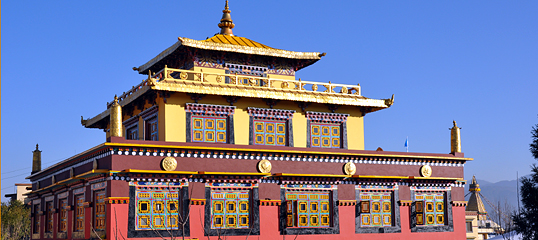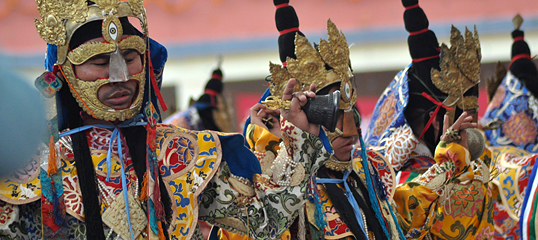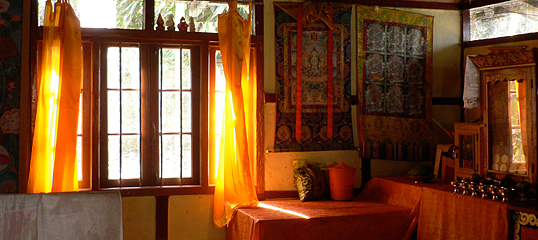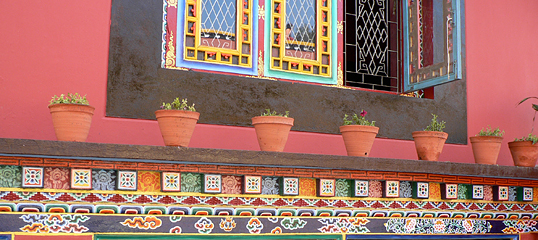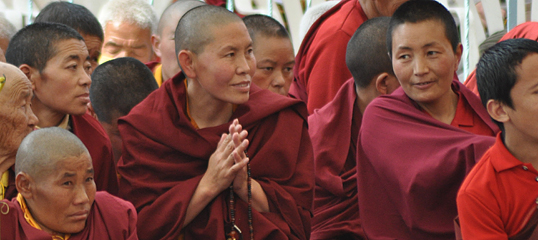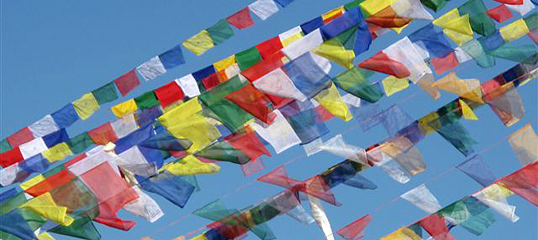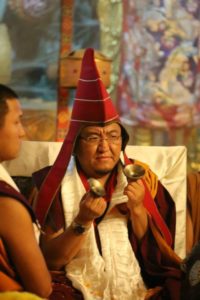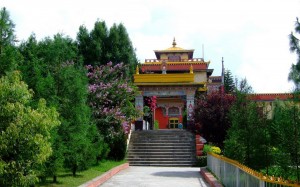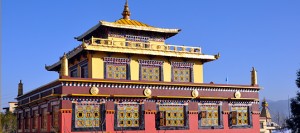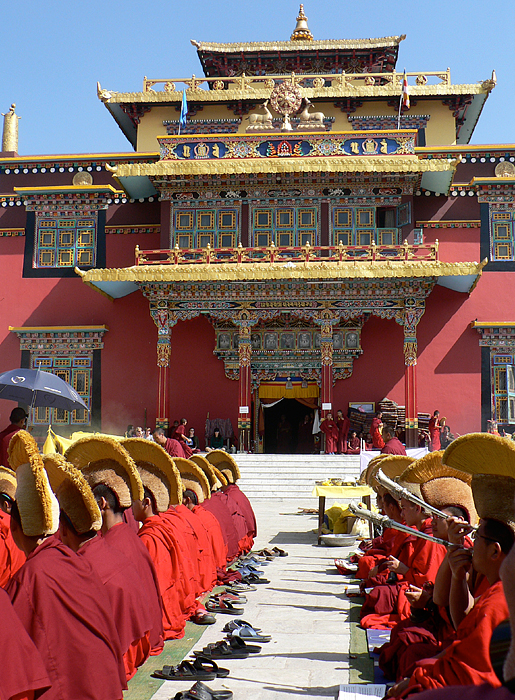Changling Rinpoche Lineage
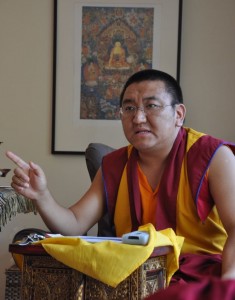 In the Nyingma tradition there are two major lineages: the lineage of oral teaching and the lineage of treasure teaching. The oral teachings are understood as the basis of the path. The actual practice has been based on the treasure teachings. These days the six major monasteries of Nyingma have performed the path of Nyingmapa. The six monasteries are Mindrolling and Dorje Drak in central Tibet, Shechen Monastery, Dzogchen Monastery, Kathok Monastery and Palyul Monastery in eastern Tibet. Those six major monasteries practice both the oral and treasure teachings. Of the six major monasteries the most renowned traditions of the lineage now are the Mindrolling and the Dorje Drak Monasteries. When we say tradition, such as the Mindrolling and Dorje Drak traditions, you must know that we are not talking about some kind of culture. It is the view, the practice, the performances of conduct and the practice of the wisdom path. This has been transmitted from teacher to student and has survived until now. That type of transmission is understood as lineage. That lineage has been named tradition. It is not just a culture. This is important to understand when you say Mindrolling tradition.
In the Nyingma tradition there are two major lineages: the lineage of oral teaching and the lineage of treasure teaching. The oral teachings are understood as the basis of the path. The actual practice has been based on the treasure teachings. These days the six major monasteries of Nyingma have performed the path of Nyingmapa. The six monasteries are Mindrolling and Dorje Drak in central Tibet, Shechen Monastery, Dzogchen Monastery, Kathok Monastery and Palyul Monastery in eastern Tibet. Those six major monasteries practice both the oral and treasure teachings. Of the six major monasteries the most renowned traditions of the lineage now are the Mindrolling and the Dorje Drak Monasteries. When we say tradition, such as the Mindrolling and Dorje Drak traditions, you must know that we are not talking about some kind of culture. It is the view, the practice, the performances of conduct and the practice of the wisdom path. This has been transmitted from teacher to student and has survived until now. That type of transmission is understood as lineage. That lineage has been named tradition. It is not just a culture. This is important to understand when you say Mindrolling tradition.
Although the previous Changling was engaged in the Nyingma lineage belonging to the Northern Treasures tradition, Dorje Drak is the main seat for that treasure tradition. Along with the Nyingma lineage, the Changling also performed or practiced the Kagyu School. This is the Kagyu tradition that comes from the master Rechungpa, the most beloved student of Milarepa. Milarepa’s major and most beloved student was Rechungpa. That is how I have been connected with the Northern Treasures. As an individual, the lineage or tradition in which I was brought up was the Mindrolling lineage and tradition. That is how His Holiness Dilgo Khyentse Rinpoche brought me up from 1986 to 1991 and also by Shechen Rabjam Rinpoche. When Khyentse Rinpoche passed away I was under the guidance of Rabjam Rinpoche. Besides those two the closest lineage teacher was Kyabje Trulshik Rinpoche for studying and practising the Mindrolling lineage or tradition. Trulshik Rinpoche himself was one of the major holders of Mindrolling tradition. After the passing of Khyentse Rinpoche and then Minling Trichen, Trulshik Rinpoche was the last surviving holder of Mindrolling tradition. In my studying of the tradition and lineage, he was the closest teacher that I had to learn from. I ended up with the Mindrolling tradition because Shechen Monastery is renowned as a monastery that had adopted the Mindrolling tradition. It was the second Shechen Rabjam who founded Shechen Monastery based on the Mindrolling tradition. He practiced exactly the Sadhanas that have been practiced in Mindrolling Monastery and also the rituals. Everything had been performed exactly according to the Mindrolling tradition. That is why Shechen Monastery is one of the renowned monastery holders of Mindrolling tradition. Mindrolling itself is a monastery. I do not have to tell you about the Mindrolling history because there are other references.
Dilgo Khyentse Rinpoche
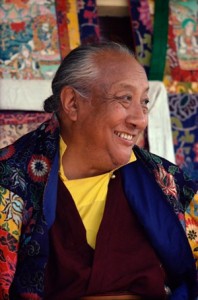 The source of our path, all of us here, is Dilgo Khyentse Rinpoche. Whether it comes from me or from another teacher, we are all here equally. It is clear that the source of our path or lineage is from Dilgo Khyentse Rinpoche whether it comes from the Sakya way or the Nyingma way. Whatever way it comes, it comes from Dilgo Khyentse, that is for sure. As we know, Dilgo Khyentse Rinpoche had teachers from all the schools. He had been trained and perfected in all the different traditions and lineages. Since he was recognised and brought up by Shechen Gyaltsab, who was one of the Tulkus of Shechen Monastery, he adopted the Mindrolling tradition as his personal tradition. Even though another renowned master of our times, Dudjom Rinpoche, had his own individual treasure teachings, Dudjom Rinpoche himself studied at Mindrolling Monastery at a young age. He entered Mindrolling Monastery and studied the full curriculum of the Mindrolling system. Even in his own individual personal treasure and also the treasure of his predecessor, Dudjom Lingpa, he adopted completely the Mindrolling tradition. From the point of Nyingma view in our times, the main sources were Dudjom and Khyentse. Both had been brought up within and established their own traditions as Mindrolling. Because I was brought up by Khyentse Rinpoche in Shechen Monastery, you can understand how I have ended up in the Mindrolling tradition. This is maybe my karma also from a previous karmic connection.
The source of our path, all of us here, is Dilgo Khyentse Rinpoche. Whether it comes from me or from another teacher, we are all here equally. It is clear that the source of our path or lineage is from Dilgo Khyentse Rinpoche whether it comes from the Sakya way or the Nyingma way. Whatever way it comes, it comes from Dilgo Khyentse, that is for sure. As we know, Dilgo Khyentse Rinpoche had teachers from all the schools. He had been trained and perfected in all the different traditions and lineages. Since he was recognised and brought up by Shechen Gyaltsab, who was one of the Tulkus of Shechen Monastery, he adopted the Mindrolling tradition as his personal tradition. Even though another renowned master of our times, Dudjom Rinpoche, had his own individual treasure teachings, Dudjom Rinpoche himself studied at Mindrolling Monastery at a young age. He entered Mindrolling Monastery and studied the full curriculum of the Mindrolling system. Even in his own individual personal treasure and also the treasure of his predecessor, Dudjom Lingpa, he adopted completely the Mindrolling tradition. From the point of Nyingma view in our times, the main sources were Dudjom and Khyentse. Both had been brought up within and established their own traditions as Mindrolling. Because I was brought up by Khyentse Rinpoche in Shechen Monastery, you can understand how I have ended up in the Mindrolling tradition. This is maybe my karma also from a previous karmic connection.
The Mindrolling Tradition
The Mindrolling tradition is an oral lineage. Although in Mindrolling they do practice treasure teachings, the original tradition of Mindrolling is an oral lineage. The Nyingma oral lineage, including the oral lineage of Mindrolling, comes from the School of Zur. All over Nyingmapa it has been renowned as the unmistaken, unbroken tradition of Padmasambhava that has been preserved by the Zur School. The reason why the founder of Mindrolling, Terdag Lingpa, adopted the Zur lineage in the Mindrolling tradition was that Zur was the unmistaken, unbroken tradition of Padmasambhava himself. This is why in Nyingma the Zur has been seen as very important. The tradition of Nyingma rituals having been performed according to the Zur tradition is for this reason. The person who saved the Zur tradition later was Terdag Lingpa. Eventually the Zur tradition emerged as the Mindrolling tradition. The Mindrolling tradition is the same as the Zur tradition because Terdag Lingpa worked so hard to adopt and purposely establish the Zur tradition at the Mindrolling Monastery. Later that tradition emerged as the Mindrolling tradition. There are also some treasure practices such as Terdag Lingpa’s own treasure, the treasure of Nyang and the treasure of Chowang. Those masters’ trainings were also involved. However the basic tradition is Zur. Now we do not have anything called Zur, but Mindrolling itself is Zur because of the strong influence of the Mindrolling brothers. We called them the brothers of Mindrolling: Terdag Lingpa and his younger brother Lochen Dharmasiri. Because of those two working so hard, the Zur tradition later had to be transmitted through those two. Because of the influence of those two, the Zur emerged as the Mindrolling tradition.
This Mindrolling tradition became a renowned tradition in Nyingma during the time of Jamyang Khyentse Wangpo, Jamgon Kongtrul, Chokgyur Lingpa and so forth. When you say Khyentse tradition, both Jamyang Khyentse Wangpo and Jamgon Kongtrul adopted the Mindrolling tradition in their treasures and in their lineage. Chokgyur Lingpa also adopted it. When Chokgyur Lingpa discovered treasure teachings there were many treasure teachings and instructions on how to perform them. Chokgyur Lingpa had a pure vision and he established it. This is in the Chokling Chokgyur Lingpa biography, and it is very clear. Since Jamgon Kongtrul and everybody said that the Mindrolling tradition is the Zur tradition, and that it is the unbroken lineage of Padmasambhava, we should all adopt that. Chokgyur Lingpa also agreed. Chokling regarded his treasure practice and its performance as the Mindrolling tradition. Even the making of a torma and holding the symbols of vajra and bell are according to the Mindrolling tradition. Sometimes, the treasure revealer-master had a pure vision. Due to that, there may be some differences. However, the basis is the same. When Kongtrul started the huge collection of treasures he adopted completely the Mindrolling system. Many treasures later, even Longchen Nyingthik also adopted the Mindrolling tradition. Jigme Lingpa also adopted the Mindrolling tradition. Later more treasure masters adapted their path according to the Mindrolling tradition. The Mindrolling tradition merged with many individual treasure teachings such as Longchen Nyingthik, the Khyentse, Kongtrul, Chokgyur Lingpa, Dudjom and so forth.
The teachings that existed before the Mindrolling tradition had their own style. For example, Pema Lingpa and Ratna Lingpa came before Terdag Lingpa. Each had its own tradition. Northern Treasures were also before Pema Lingpa. So it too had its own tradition. Following the treasures that came later, after Terdag Lingpa, a few adopted the Northern Treasures tradition, but most adopted the Mindrolling. Even the Khyentse lineage is none other than the Mindrolling tradition. Therefore it is important to perform the practice, sadhana and the path based on this tradition. Otherwise you cannot do it properly. Without a tradition there is no structure. That is what it means when we say that it cannot be performed properly. It has to be performed through a structure.
Based on the Mindrolling tradition, our main focus is on the five treasure teachings of Dilgo Khyentse, Nyang Nyima Oser, Guru Chowang, the Northern Treasures and Terdag Lingpa. Because I am responsible for the Northern Treasures, I have to adopt that. We call the treasures of Nyang and Chowang the King of all the Treasures. We have the saying: “if everybody is responsible, then nobody is responsible.” Things get left out when this happens. Individuals need to take responsibility. This is how Nyang and Chowang became subtle. Dilgo Khyentse was personally strongly devoted towards Nyang and Chowang treasures because they are understood as the supreme of all the treasures. The rest of the treasures are manifestations of the Nyang and Chowang. The original treasure teachings were Nyang and Chowang. The rest emerged from that. That is how it has been seen. Nyang has lots of traditions: the Eight Heruka and the Vajravarahi come from the Nyang tradition. The Guru Sadhana and the Vajrakilaya Sadhana come from the Chowang tradition. These four were the main deity practices in the Mindrolling tradition. They have been strongly performed in the Mindrolling tradition. Those masters who have been brought up within the Mindrolling tradition also adopted these practices. Dilgo Khyentse also adopted those four practices. We know that whatever the teacher is strongly connected to influences the students as well. This is the influence of Nyang and Chowang.
The Vajrasattva comes from the Mindrolling tradition. The Blue Wrathful Guru Rinpoche comes from the Northern Treasures. From the Northern Treasures came Kilaya and the Dzogchen cycle of Northern Treasures. Of the treasure teachings of Khyentse Rinpoche, the main one is the Life Essence of the Immortal Lotus, which is based on Padmasambhava in the form of Amitayus. The lineage of these comes mainly from three masters: Khyentse Rinpoche, Trulshik Rinpoche and Taklung Tsetrul Rinpoche. The Northern Treasure cycle is from Taklung Tsetrul Rinpoche. Along with the Nyang and Chowang tradition, some are from Khyentse Rinpoche. Others are from Trulshik Rinpoche and from Taklung Tsetrul Rinpoche. Mindrolling Vajrasattva is from Dilgo Khyentse directly. The treasure of Khyentse Rinpoche is from Trulshik Rinpoche. HH Khyentse Rinpoche received some of these treasures from his root teacher Shechen Gyaltsab and some from Khyentse Chokyi Lo
dro. Trulshik Rinpoche received the Nyang and Chowang treasure teachings from Khyentse Rinpoche and from someone called Minling Chung Rinpoche. Minling Chung Rinpoche is the uncle of Minling Trichen who passed away. Taklung Tsetrul Rinpoche’s source is Northern Treasure. He is the Northern Treasure lineage master. The Nyang and Chowang tradition is from the previous sixth Shechen Rabjam, Dudjom and Dilgo Khyentse. It is from those three masters.
The Khyentse Lineage
hen we say Khyentse lineage, this is similar to the practices of Khyentse Wangpo and Dilgo Khyentse. Some practices are those of Khyentse Wangpo, like us. In my lineage, I also have the Khyentse lineage in the tradition of Mindrolling. I have the Khyentse lineage. My Khyentse lineage is the Dilgo Khyentse lineage. The Dilgo Khyentse lineage is a merged lineage of Khyentse Wangpo and Shechen. I fall in the Khyentse and Northern Treasures lineages and the Minling as a tradition. That is how we can put it in the tradition of Mindrolling. Although the Nyang and Chowang traditions are adopted by the Mindrolling lineage, I have put all these into the Khyentse lineage along with Khyentse Wangpo. This Khyentse lineage is my personal connection.
Northern Treasure
Northern Treasure is my responsibility. It is not because of my previous practise. Partly it is because of the teacher’s order, Khyentse Rinpoche’s order, that my mission is to work with Northern Treasure. The other part is that when someone is recognised as an incarnation, it means you have been picked to work, a work that does not have retirement. That is what it is meant by recognising. There have been lots of hopes and aspirations placed on you when you have been recognised. For example, when Khyentse Rinpoche recognised a person, he was not recognising because he had nothing to do or he wanted more things to be done. The concept of recognising is to preserve the teachings. I was not brought up in the same environment that was mainly connected with my predecessor. Nonetheless, I feel responsible not only because of aspiration, but also because of my teacher’s aspirations for me, and his direct order to me. I feel responsible because of these two reasons.
Northern Treasure has its own tradition. Dilgo Khyentse wanted it to merge with the Mindroling tradition. This is why in our tradition the two lineages have merged.
Obviously the oral lineage is involved. When we say Nyingma is an oral lineage, this does not refer to a treasure; it refers to the oral lineage. There are different oral lineages. The Zur tradition is the only oral lineage that exists now. Besides this, from a philosophical view and from the point of view of general Buddhist philosophy, the Nyingmapa philosophy is Madhyamika. From Madhyamika, it is the Yogacharya Madhyamika philosophy that was founded by Santaraksita. Yogacharya Madhyamika is a combination of both philosophical schools of Mahayana: Yogacharya and Madhyamika. Yogacharya is the Mind-Only School or Cittamatra. Cittamatra has two names: Cittamatra and Yogacharya. The path of sutra in Nyingma, and later in Rongzom and Longchenpa’s philosophy, became the heart essence of Nyingmapa sutra philosophy. All the Nyingmapa follow the philosophy of Rongzompa and Longchenpa. The renowned Lama Mipham Rinpoche’s philosophy is none other than that of Rongzom and Longchen. On a general level, this is the basis of our philosophy. On the Vajrayana level, we also have the Vajrayana tradition of Zur. On the Vajrayana level there are two institutes: the Zur Institute and Ronglong institute. The main focus is on the Zur institute within the Vajrayana state.
Besides this Nyingma, I have been connected with the Rechung Kagyu School. I am not going to elaborate so much on the Nyingma lineage details because there are lots of sources and references. But I would like to give a little explanation of Rechung because that is not very well known. The Rechung Kagyu School comes from Milarepa. From Milarepa, the Kagyu teachings emerged into three lineages: the lineage of Dagpo Gampopa, the lineage of Rechung and the lineage of Ngamzong. These lineages are the whispering lineages or the oral lineages. We can say these are the oral lineages or the lineages of hearing or the dakini-hearing lineages of Chakrasamvara. In Tibetan it is called demchok khandro nyengyu, the Dakini-Whispering Lineage of Chakrasamvara. Milarepa gave it to those three students and the lineages come from there.
Tilopa and Milarepa
Now let us go back to the story. The founder of this lineage is Tilopa. The Vajrayana tantra that Tilopa received was directly from Vajradhara. To make other people comfortable or confident he had four human teachers. However the actual source of the Vajrayana teachings of Tilopa is Vajradhara. Later when Tilopa went to Odiyana, the land of Vajrayana or the land of Dakini, Tilopa met Vajrayogini in a real form. Vajrayogini showed him three symbols, symbolic of body, speech and mind. When she showed him the three symbols, Tilopa realised and recognised what they were. Then Tilopa supplicated Vajrayogini to give him the essence of Vajrayana teachings from these symbols of body, speech and mind. As Tilopa knew correctly the symbols that had been elaborated upon in Tilopa’s biography, he supplicated Vajrayogini who gave him the Dakini Whispering Lineage of Chakrasamvara teachings. These are called the Three Jewel Cycles of Dakini Whispering Lineage. We called them the Nyengyu Norbu Kor Sum. Nyengyu means the hearing lineage, norbu means jewel, kor means cycle and sum means three. The Three Jewel Cycle is the complete form of the Dakini Hearing Lineage of Chakrasamvara. Then Tilopa passed this to Naropa. This is the source of Mahamudra. Naropa transmitted this to Marpa. Marpa went to India three times and later Marpa met Milarepa. Milarepa went through all the hardships and finally, when Marpa knew that Milarepa’s negativities had been purified, Marpa gave Milarepa some teachings. Then Milarepa started to practice.
One day Milarepa had a dream. It was like a state of dream and also awake. In that state a Dakini prophesised and said “tell your teacher Marpa to go to India and fetch the Whispering Dakini Lineage instructions or the pith instructions, as your teacher still has not received them from Naropa.” When Milarepa woke up the next day he was not too sure if that was a Dakini prophecy or an obstacle. He went to Marpa and told him of his dream. When Marpa checked he found that it was a perfect Dakini prophecy. Although Marpa was in his late fifties, he decided to go to India even if it was going to cost his life. Marpa went to India but Naropa had already entered into Kechari or into the state of performing conduct. This means having entered into the Kechari. Marpa went in search of Naropa but could not find him. Finally Marpa did a massive feast offering practice to be able to receive Naropa. Once those masters, Mahasiddhas, have entered into the secret conduct or the Kechari, only fortunate students, one or two, can receive them. With the massive practice of feast offering, Marpa was finally able to meet Naropa at the Pulahari Mountain. When Marpa met Naropa at Pulahari, Marpa supplicated Naropa to grant him the Dakini Whispering Lineage. Naropa was quite surprised when he heard that. He said: “Who told you that I had this?” Marpa said he had a student called Thopagawa, which was actually Milarepa’s name. Thopagawa had had a dream or prophecy, which was how Marpa found out. Then Naropa praised Milarepa. Anyway, Naropa finally granted that teaching. Naropa had not mentioned it even in the Marpa’s previous visit. He had not dared to mention it. Marpa would not have bothered to get this teaching if Milarepa did had not have had the prophecy. Naropa had kept that it as a secret. Finally, Marpa succeeded. He returned to Tibet. Although Marpa had four major students, but only Milarepa was the one who held the Lineage of Accomplishment, the practice of accomplishment. Marpa transmitted it only to Milarepa. Through this path of teaching, Milarepa attained the state of Mahamudra.
Later Milarepa had a gathering of many students. Vajrayogini had prophesied that Milarepa should start to divide the teachings and give them to his students to take responsibility. A few of Milarepa’s major students had already entered into the Kechari, there were only three remaining: Gampopa, Rechungpa and Ngamzong Tonpa. Milarepa divided the teaching into three levels: elaborate version, average version and short version in word form. Milarepa gave the elaborate version to Gampopa, the average version to Rechungpa and the shorter version to Ngamzong Tonpa. From the three, there came the Dagpo Nyengyu, the hearing lineage of Gampopa Dagpo, the Rechung Nyengyu, the hearing lineage of Rechung, and the Ngamzong Nyengyu, the hearing lineage of Ngamzong. What we call the Karma Kagyu, Drukpa Kagyu and Drikung Kagyu are all from the Dagpo Nyengyu. Rechung stayed as Rechung Kagyu only. Now Ngamzong does not exist anymore. There is only a little bit of it in the collection of the Treasure of Introduction by Jamgon Kongtrul. We call it Dam Ngak Dzo. There are three pieces. There is not much seed for Ngamzom. It is gone. Dagpo Nyengyu survives perfectly. Now with Rechung Nyengyu, I am the last piece. That is the beginning of Rechung Nyengyu or the Rechung Kagyu. That is how it began.
Rechung Kagyu
Now I am going to talk about the specialty of Rechung Kagyu. The specialty of Rechung Kagyu is this Rechung Nyengyu, the Whispering Lineage that came from Milarepa, which has been combined with the Mahamudra teachings. This is called the Formless Dakini teachings. This Formless Dakini teaching is also from Tilopa to Naropa. It is the Ultimate State of the Mahamudra teachings. Because Marpa did not succeed in receiving the full cycle of the formless Dakini teachings during his last visit to India, he told Milarepa that one of his students would fetch the remainder of this teaching in the future. He gave that prophecy. When Milarepa had students he said to Rechungpa one day: “My teacher has given the prophecy and that is none other than you. You should go to India and fetch the Formless Dakini teachings and bring to Tibet.” The Nyengyu Norbu Kor Sum, the Three Jewel Cycle of Nyengyu or the Whispering, has only part of the Formless Dakini teachings, not the complete form. Rechungpa went to India. While searching he met this master called Tiphupa. Tiphupa was one of the eighty Mahasiddhas of India. He was one of the Mahamudra students of Naropa. Naropa granted the full cycle of the Formless Dakini teaching to Tiphupa. When Rechungpa went to India he met Tiphupa. From Tiphupa, Rechungpa got the complete Formless Dakini teachings, together with some other teachings from Maitrepa and also from one female Mahasiddha. Her name in Tibetan is Machig Drubpey Gyalmo, drubpey gyalmo means queen of accomplishments.
When Rechungpa had the full cycle of teachings, his master told him: “You do not have enough life span to live. You have a very short life span. You should go and see this female master called Machig Drubpey Gyalmo. She has the full cycle of longevity tantra that she got directly from Buddha Amitayus. You should go and see her to get it.” Rechungpa searched according his master’s instructions. He met Machig Drubpey Gyalmo who said: “Now you only have one week to live.” Then she gave the longevity practice to Rechungpa. For one week Rechungpa practiced. His life span was extended to eighty years. When Rechungpa came back to Tibet with the Formless Dakini teachings, he also brought the full cycle of Amitayus, the Red Chenrezig that is the Gyalwa Gyatso, and a practice of Vajrapani. Vajrapani pacifies all types of plagues. Those three deities’ practices are understood as the Three Deities of Rechung. When Rechungpa got back to Tibet Milarepa said to him: “First give me a teaching that you brought from India that is not born in Tibet at all.” So Rechungpa offered Milarepa the longevity practice of the Queen of Accomplishment. Milarepa became the student when he received this longevity practice. Milarepa then said: “Since I am fully satisfied with the teachings that I got from my teacher, Marpa, I do not need any more, but this is needed for the future so adopt this in your tradition.” So the Formless Dakini teachings were added into the Rechung Kagyu.
Then the Rechung Kagyu became the combination of the Marpa Nyengyu, the Whispering that came from Marpa, and the Formless Dakini. The Rechung Nyengyu is understood as the only Kagyu that has the full cycle of the Three Jewels. It is only the Rechung Kagyu that has the full cycle of Mahamudra teachings of the Three Jewels that Tilopa received from Vajrayogini. Later, Drukpa Kagyu was strongly influenced by Rechung Kagyu. So the Drukpa Kagyu came to have some of the formless Dakini teaching. However, the complete form is only in the Rechung Kagyu. This lineage came from Rechungpa. Later this lineage was preserved and propagated by a master called Tsangnyön Heruka. Tsangnyön Heruka was the one who collected the Hundred Thousand Songs of Milarepa. It had been prophesised that Rechungpa would again take rebirth for two purposes: to collect the Hundred Thousand Songs of Milarepa and to rebuild the Rechung Kagyu. Therefore Tsangnyön was understood as Rechungpa’s rebirth for those two purposes. He succeeded. Tsangnyön had lots of commentary on the teachings of the Three Jewel cycle that is the Whispering lineage of Dakini.
Milarepa sent Gampopa down to a place called Dhaklha Gampo in Dagpo, which is the border between U-Tsang and Kham. Tibet has three provinces, we called them U-Tsang, Kham and Amdo. These days they are called the Autonomous Region of Tibet and other areas such as Szechuan and Qinghai. Anyway, Gampopa was sent down there. Rechungpa was in central Tibet. At that time it did not seem significant but later that was seen as important. Later that influence went into the Karma Kagyu and the rest of the Kagyu.
In the rest of the Kagyu, the innermost secret pith instructions are none other than the Rechung Kagyu instructions. Later Jamyang Khyentse Wangpo was also involved in the Rechung Kagyu. Jamyang Khyentse Wangpo wrote quite a number of commentaries on the Rechung Kagyu. I got some of the Rechung Kagyu from a master called Kushok Bula who has passed away. Most of his Rechung Kagyu practices were based on Jamyang Khyentse Wangpo’s writings. That lineage is very subtle. It is in my present incarnation that I have a special connection with this. It looks like now I have the responsibility for this. That is how I am involved with the Rechung Kagyu together with the Nyingma, the Northern Treasure, and Khyentse lineage based on Mindrolling Tradition, on the general philosophy of Ronglong and the special institute of the Zurpa or the Mahayoga tradition. It is a combination of Mahamudra and Dzogchen. The previous Changling also had two groups of students, Nyingma and Kagyu. When a Nyingma student came and requested Dzogchen, he taught Dzogchen. When they came and requested Mahamudra, he taught Mahamudra.
In Rechung Kagyu there is the preliminary stage, the development stage and the completion stage with characteristics. There are six stages of completions, and a completion stage without characteristics with Mahamudra. The basis of the Rechung Kagyu is none other than the writings of Milarepa. The writings of Milarepa only exist in Rechung Kagyu. The rest of the Kagyu do not have these writings. Rechungpa was his most beloved child, son or student. Milarepa gave Rechungpa the teachings both verbally and in writing. With the rest of the students, he gave it only verbally. The root texts of Rechung Kagyu are the actual writings of Milarepa. The practice manual instructions are based on that. Tsangnyön, Khyentse Wangpo and others’ commentaries are based on Milarepa’s writings. In these writings it says that Dorje Gyaltsen was Milarepa’s name when he received empowerment. Dorje Gyaltsen is always mentioned at the end of the sections with the words: “The father Dorje Gyaltsen wrote with great love to his son Rechungpa.”
The Rechung Kagyu is stricter than the rest of the Kagyu tradition. When I was receiving I said:
“Can you do this and this now?” Kushok Bula said: “Just because you are the incarnation do you think I can give it?” He said: “Forget it. First you do this completely. Then come back.” Until then he would say: “No, even if you are the incarnation of this and that, I do not care. This is how it is.” But I could not get the complete teaching because we could not find all the books. When I did find all the books, there were around thirteen volumes. By then Kushok Bula had died. So we got certain parts. What we really missed in between were the Trulkor exercises. The Trulkor exercise of Rechung Kagyu is known as the most profound level of Trulkor exercise in Kagyu. Some of those exercises do exist in Drukpa Kagyu. Many have been telling me to recover them from Drukpa Kagyu. The Six Yogas of Naropa Trulkor in Drukpa Kagyu is very strong. Some parts of the exercises do exist in the Rechung Kagyu, but the Rechung Kagyu exercises independently are no more, gone. Kushok Bula was the last piece and he is gone. Lama Trakden was also in this category. He told me that when you have done the Trulkor exercise then you take the examination. The examination is on the prana and chandali. In the examination of chandali you have to go to the middle of the mountains in the snow, take off all clothes and meditate in the snow. You have to make sure that you are able to melt snow down at least the height of one storey of a building. They meditate and melt into the snow. They go down and down for at least one storey. When you are able to do that, then the exam has been passed. As for the prana, you have to race with a horse. You have to be ahead of the horse. This is the prana exam. I asked Lama Trakden if it is just a story and had he seen this. Lama Trakden said that yes, he had see this done by someone; his name was Gelong Phenthok La. He used to be the chant master of the monastery. Lama Trakden said: “I have seen with my eyes Gelong Phenthok La when he was being examined by the previous one. First, when they started running, the horse was ahead and finally Gelong Phenthok La caught up and went further.” He was faster than the horse. I wished I could say that he got the Olympic gold medal. This is how it used to be examined.
In the Rechung Kagyu three-year retreat they make a boundary of scorpions. When the retreat starts and they put up the boundary, the retreat will be surrounded by scorpions, hundreds of scorpions. When the retreat finishes and they open the boundary the scorpions vanish. Nobody dares to go through, only the one who has responsibility for taking food in and out. That one only can pass; the rest will not dare to go there. The retreat will be surrounded by hundreds of scorpions. Lama Trakden said he saw all this with his own eyes. Even Kushok Bula and everybody said they saw the hundreds of scorpions with their own eyes. They said it was like black ants and nobody would dare to go there. Nobody would dare to come out. After they open the boundary they vanish and again when they close the boundary they come out again. Now we do not have this Trulkor exercise but we still have the part of the tummo. It is gone. Otherwise we could have gone to the Olympics and got gold medals. I am sure you can get one if you run faster than a horse. Even Lama Karma Tsundro who passed away last year said he did not reach that level of chandali, but he saw who had reached that level that was the 6th Chakphuk Tulku Kunsang Tenpe Gyaltsen. In a couple of hours they were lost and you could see a big hole in the snow. Lama Karma Tsundro used to laugh and said, “Now when they are doing chandali they put on a wet cloth,” he laughed at that. He said in his tradition they melt one storey of snow with the chandali. He said, “What is there to be surprised about with drying a piece of cloth? In my tradition they melt snow!”
